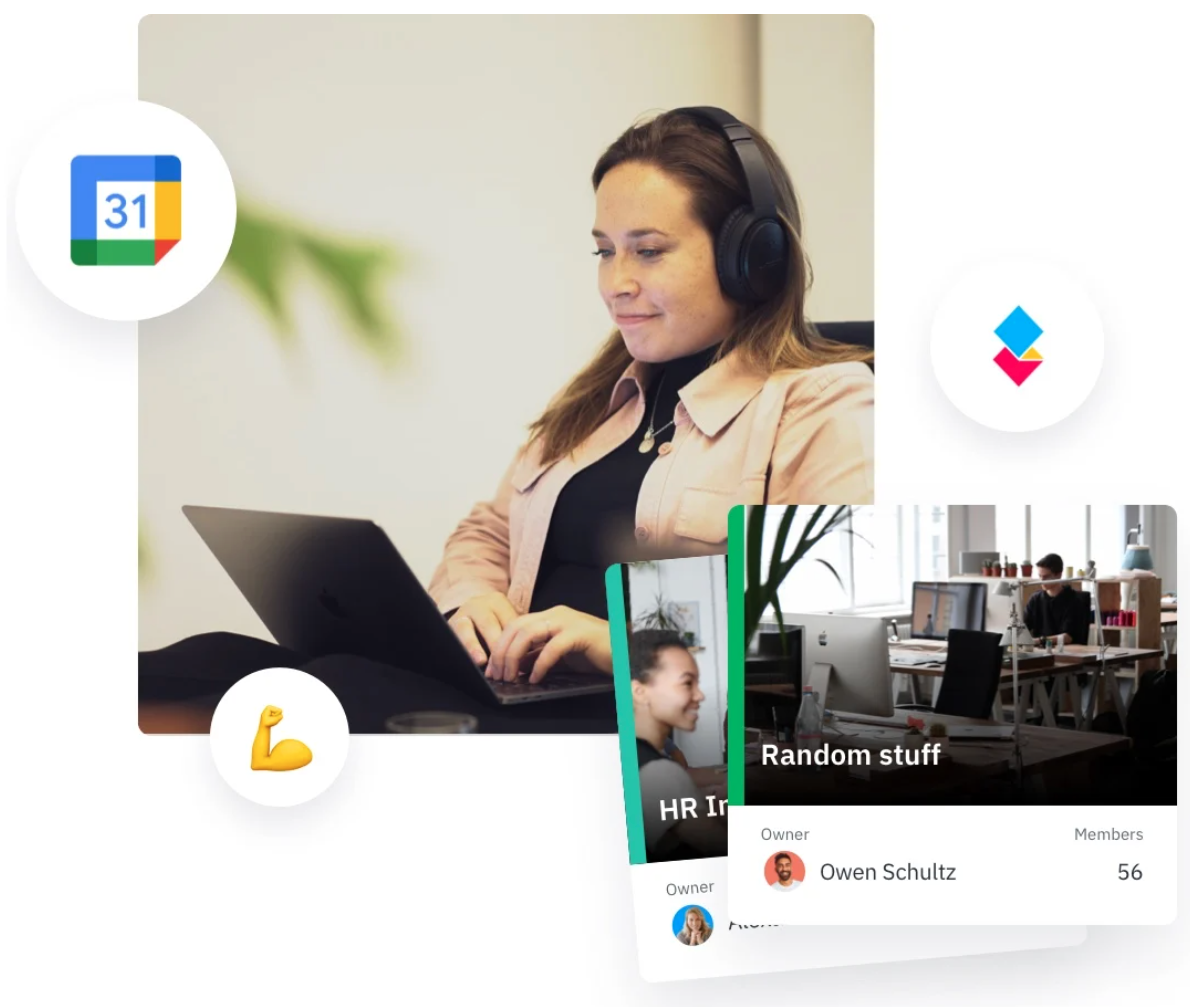

12 employee engagement ideas for remote teams in 2024

Jonathan Davies
25 mins read
Thu, Apr 11, '24
In today's fast-paced environment, the demand for remote work is growing, as well as the importance of keeping remote employees engaged.
According to Gallup State of the American Workplace Report, remote workers are more engaged (32%) than office workers (28%). Engaged employees are often top performers who are committed to going the extra mile to achieve success. When remote employees don't feel engaged with their work, the entire organization is likely to suffer, and vice versa: having engaged employees has a positive impact on retention, customer satisfaction, company reputation and even stakeholder value.
Want to engage your remote workers?
Watch video
What does working remotely mean?
Working remotely is a working style that allows professionals to work from outside the company’s office. In many cases remote work refers to working from home, but may include anywhere away from the office, such as a café, a library, the beach, a car, a train, or even a coworking space.
What is employee engagement?
Employee engagement is a concept that describes the relationship between an employee with its organization. Engagement defines the emotional commitment the employee has to the organization and its goals. An engaged employee is enthusiastic, involved and committed to their organization and to their work, and will typically go the extra mile.
We realize that engaging with remote employees can be a challenge for organizations. Our remote working solutions make it easy for teams to communicate and collaborate, and feel engaged across borders and different time zones. Learn why remote-employee engagement is important, what are the challenges that come with it, and how to overcome them with our ten ideas on how to boost remote employee engagement.
How to engage remote employees?
We know that increased engagement in remote work has proven to help boost productivity, but managing a remote workforce isn’t always easy. So how to engage remote employees? In this article, we’ll cover 10 of the best ideas for engaging remote employees, all centered around three main elements: communication, understanding, and appreciation.
Challenges and benefits of remote employee engagement
Remote work may be new to the majority, but for some of us it’s business as usual. The world is ever-changing and organizations need to adapt quickly to the remote work trend if they want to stay in the game.
However, remote working comes with challenges for both employers and employees. There’s a variety of distractions – from kids to parents and pets, to preparing lunch and doing the dishes. Another challenge is communicating and collaborating efficiently: messages won’t be answered as quickly, and some of them will just be forgotten, while last minute changes in schedules take place more often. Inefficient communication and collaboration can ultimately lead to disengagement – a risk you should avoid at all costs.
There is no doubt that creating an engaged remote workforce is vital to the success of a business. Engaged employees are more motivated and care about delivering quality work full-time. By investing in remote employee engagement, businesses can reduce absenteeism by 41%, turnover by 59% and the associated hiring costs. Managers may also increase productivity with up to 17% while retaining top talent.
We know that increased engagement in remote work has proven to help boost productivity, but how to keep remote employees engaged? Throw the traditional work mentality out the window – of your dining room, in all likeliness. Adapt your schedule to your remote employees’ needs, understand asynchronous communications, minimize the number of meetings, and reinvent your Internal Comms process.
We know that keeping remote employees engaged can be a challenge to companies, especially when you run out of ideas. In case this is something you’re struggling with, here are some of the best ideas for engaging remote employees.
10 remote employee engagement ideas
1. Set clear goals for remote employee engagementIf your company wanted to increase sales or improve customer service, they would create a plan to achieve these goals. In the same way, remote employee engagement needs to become a part of your overall business strategy. Developing a remote engagement program could include objectives such as improving Internal Communications or implementing company-wide pulse surveys on a regular basis. Share these objectives to raise morale and empower remote teams.
There is no point in setting goals if you cannot measure their impact. Once you have identified the main focus of your remote employee engagement program, you should develop S.M.A.R.T goals. These are objectives that are specific, measurable, attainable, relevant, and time-bound. Be clear about what you want to achieve, and make sure to set milestones and KPIs so there is accountability as well.
2. Plan fruitful remote meetings to engage remote workers
Regular one-on-one meetings are important to keep remote workers engaged. These meetings give managers the opportunity to receive valuable feedback while understanding the needs and concerns of their employees who work from home. There are a variety of topics that can be covered during one-on-one meetings, including:
- What are your goals and priorities this week?
- How satisfied are you with company communications?
- What can we do to make your job more efficient?
- How do you feel about your work-life balance right now?
- Is there anything we didn’t cover that you would like to discuss?
In order for one-on-one meetings to be effective, they need to happen on a regular basis. Google Meet is the perfect face-to-face video conferencing solution to set these events and keep them organized. Even better, Google Meet allows users to schedule these video calls in their work calendars based on time zone differences and availability.
Make remote calls a moment to connect and enjoy the simplicity of being present with other people when we can’t enjoy their physical presence. We’re happy to offer some ideas to make your remote calls enjoyable. Let’s bullet-point our way through to avoid the fluff.
- Know your software. A meeting can’t be fun when spending the first 5-10 minutes explaining how to enable the tiled view in Meet.
- Be punctual.
- Introduce everyone to avoid awkward silences.
- Facilitate small talk and dedicate a meeting entirely to fun-related activities.
- Ask if people understood your message, right then and there – don’t guess that they did.
- Make sure everyone’s voice is heard and valued.
3. Create a remote employee reward system
Rewarding hard work is one of the best ways to engage remote employees and improve company culture. Company rewards could include career coaching and professional development opportunities or financial benefits such as bonuses and gift cards. Managers can conduct a quick survey to determine which rewards are most desired among the group.
Financial incentives are not the only benefits remote workers are looking for in a job. Recognition among colleagues can have a long-term impact on employee engagement and job satisfaction. This means leaders need to go out of their way to notice and acknowledge when an employee makes a positive contribution. Public recognition during a company-wide meeting is a great way to celebrate achievements that impact the business as a whole and give workers a sense of belonging.
4. Implement remote-work software
With the rise of home offices, digital platforms and applications have come a long way in keeping remote employees engaged, even if teams are scattered in different time zones. When looking for the right communication and collaboration channel, consider what features will be most beneficial to your specific needs. Remember that no matter how good your remote work platform is, your employees still need to be trained to use it to be productive and feel engaged.
Traditional offices may have used faxes and emails in the past, but remote employees work, communicate and engage in very different ways. When it comes to platforms for remote workers, the choices are robust. The best ones enable remote employees to communicate and collaborate seamlessly regardless of their location or working hours. Our suggestion? Happeo is the intranet platform and the one-in-all digital workplace that integrates deeply with Google Workspace’s productivity suite.
5. Offer gamification
Gamification is a growing workplace trend that has been shown to increase employee engagement and motivation. These games use an online platform to help employees reach different goals and objectives, offering rewards as they advance through the system. Gamification is useful when onboarding new remote workers or training existing employees on products and policies. The game dynamics, such as earning points and badges, makes the process much more engaging and fun. Companies can even assign real rewards for digital prizes.
6. Set creative remote employee engagement activities
All of us know this by now – working from home comes at a price. It can get hard to get the motivation, creativity, and spirits up and running. Although a majority of the remote workforce enjoys being productive outside of the office, communicating face-to-face is still essential to improve remote employee engagement. To solve this problem, managers may dedicate time during the day for extracurricular activities – the goal is for remote employees to feel connected with each other.
Discover all the features of a remote work software
Download list
7. Meditation, yoga & well-being classes
The well-being industry is booming. Meditation, yoga, nutrition, and related practices, or simply a midday coffee break can have a significant impact not only on the well-being of your employees but also, surprise, surprise – on their output. New players have also taken a seat at the table, like the Wim Hof Method – a practice focused primarily on deep breathing and cold exposure with overwhelmingly positive anecdotal and scientifically proven results. Imparting a course about these methods and practices should not take longer than an hour or two out of your working hours, and the practices themselves can swiftly be incorporated into the tightest of agendas. A meditation practice can be carried out in ten minutes a day.
8. Online courses & workshops
Enable education in the workplace for long-term results. Providing your employees with memberships for audiobook platforms, e-book devices, online courses, and workshops will give them not only the freedom to choose what to learn, but also get them interested in new things that are beneficial for an organization striving to be broad-minded. Enabling education in the workplace gives long-term results and boosts employee productivity by 8.6%.
Simple measures work, but not everyone will be keen to join. It’s important to market your activities accordingly and to create excitement around them with the help of your Internal Comms leaders.
9. Engage with management and facilitate communication
Oftentimes, management doesn’t participate in team-building activities or promotes solutions for teamwork. If your management, or anyone for that matter, is not joining or is not enthusiastic about team activities and remote calls, the logical step to take is to ask yourself why.
One of the main reasons that Jason Anthoine highlighted was that, when it came to senior management, some people were nervous to use new, tech-oriented solutions. What he realized was that they simply didn’t know how to use the tech. He understood that something as simple as talking to someone close to the person in question, and checking if they know how to use the technology usually did the trick. No one wants to feel like they’re falling behind, so a quick check-up on how people feel about new ideas can positively affect remote engagement.
Once you’ve made sure everyone is on the same page technologically speaking, take a look at your communication channels. A constant flow of information is often unnecessary and tiresome for all parties involved. Keep it simple, and market your internal activities appropriately – a message on a boring-looking intranet is not enough. Create custom approaches to your communications. A newsletter might work for one department, but a four-second video might be better to approach another. It doesn’t necessarily translate into creating lots of content to promote internal messages, but it’s good to know what people react to, and why. Personalization enables action.
10. Get creative to boost happiness
No matter how professional or serious one might be – everyone loves a good surprise. Not an okay surprise, but a good surprise is one of the easiest ways to keep everyone’s spirits up while working remotely. What if we told you you could hire Rey Mysterio, Snoop Dogg, Frodo, or Lando Calrissian to record a custom-made message for your employees, for the price of one company-paid lunch? Maybe not lunch-priced in the case of Snoop Dogg, but if you haven’t heard of Cameo, that’s pretty much the premise. A quick message or shoutout to your team members from their favorite celebrities can make more than one person’s day.
We’ve heard some crazy good ideas like organizing Fashion Fridays, or creating face-to-face discussions in Google Meet to encourage deeper conversations among employees. These are just some of the dozens of good ideas that could be used to make your employees happy. Just be mindful of the different personality types in your organization.
11. Encourage Internal Comms leaders
Employees connecting over connecting employees. That’s the motto of remote employee engagement. Enabling connection and relationship development among employees, not forcing it down their throats. Things might start getting a little boring during remote working, and that could be indicative of some points of improvement in your approach to Internal Comms. Creating a community-centered workplace is, in general terms, what you want to be aiming for.
Internal Communicators are there to enable conversations to happen, to create a constant and clean flow of information across the organization. They are the ones who listen to people, see what’s getting stuck, and keep your comms channels active. For this to happen, they need channels not only top-down, but also bottom-up. Everyone needs to have a voice, regardless of the position one has in an organization because Internal Comms focuses on people. Take a thorough look at what’s being said, by who, and why, to highlight what needs to be addressed.
12. Work-life balance
Last but not least, let your remote employees experience a loose-work culture. Don’t underestimate the liberation that can be felt when not being restricted, micro-managed, and supervised at all times:
- 77% of employees feel higher engagement and 87% feel higher job satisfaction when well-being is made a priority at their workplace
- 58% consider work-life balance benefits an important part of the internal strategy
-png.png?width=699&name=work%20life%20(2)-png.png)
However, too much of a good thing can have unwanted results, and in this case, flexibility can create ambiguous working conditions. To avoid those, there are set-in-stone practices like designating a workspace and setting working hours. You can also encourage learning about work-life balance, and if you’re on a budget, Coursera and EDX are great platforms to get free courses from the best Universities in the world.
Want to see how Happeo helps your business?
Book a demo
Find out more about Happeo
All and any activities, projects, or ideas to engage remote employees are reliant on two things: creativity and culture alignment. Real changes are an inside-out process and need organization-wide adaptability. It’s easy to underestimate how much reinventing your Internal Comms strategy can cause organization-wide remote employee engagement, especially in times of change.
Happeo is an intranet and collaboration platform that helps enterprises build long-lasting relationships with their remote teams. We are proud to work with organizations of all sizes to ensure success through digital cloud-based solutions. Get the latest on Internal Communications and Google Workspace productivity by planning a personalized demo.







.png?width=617&name=employee%20engagement%20(1).png)

